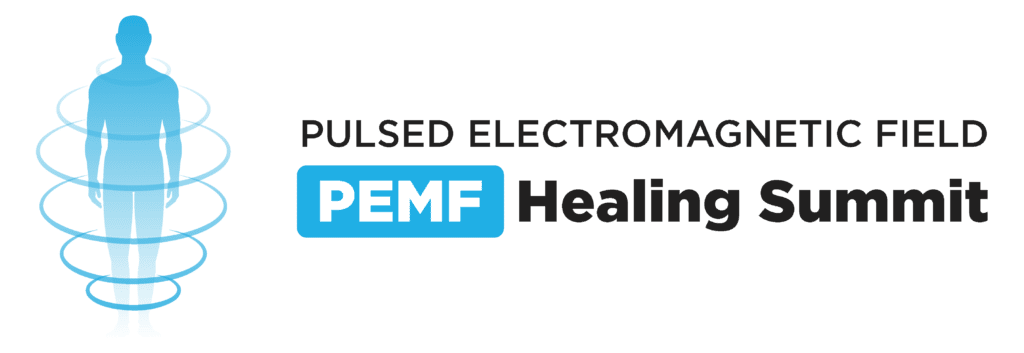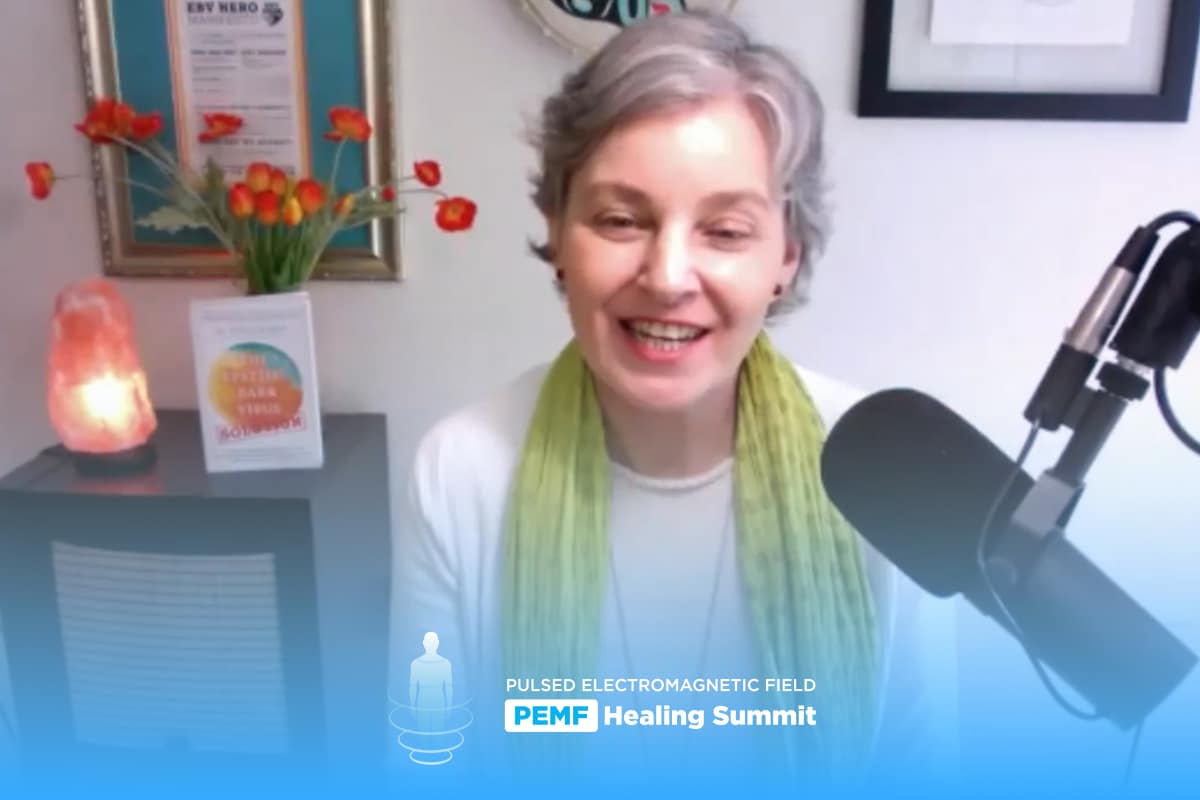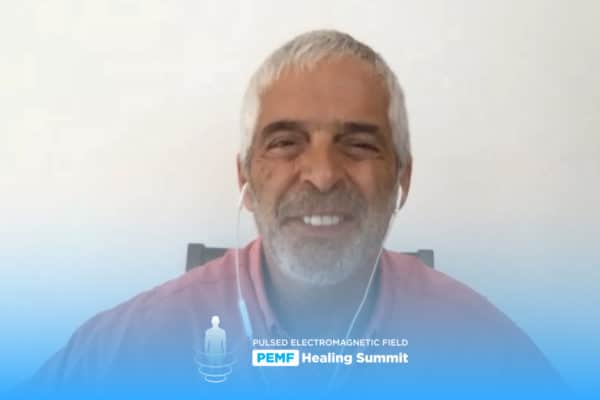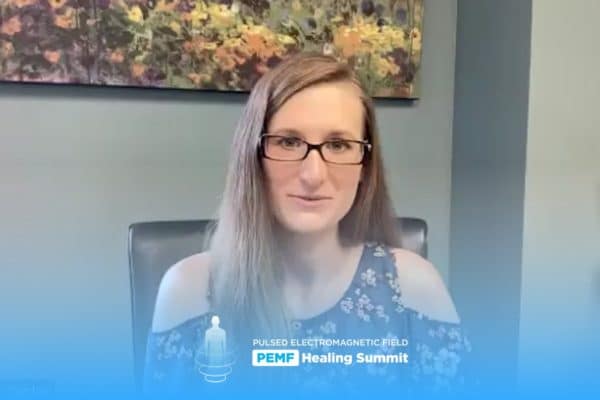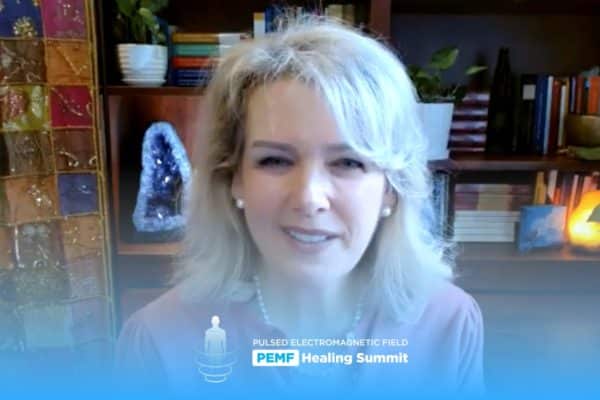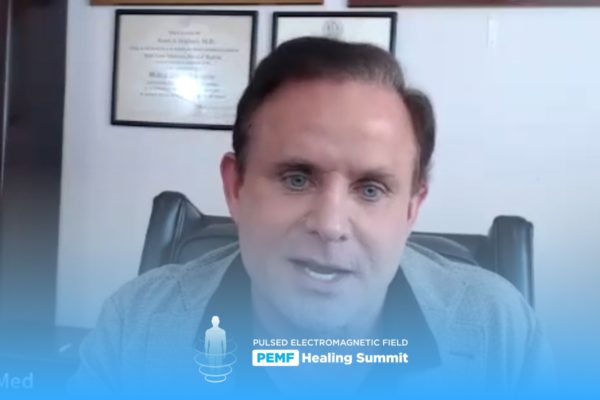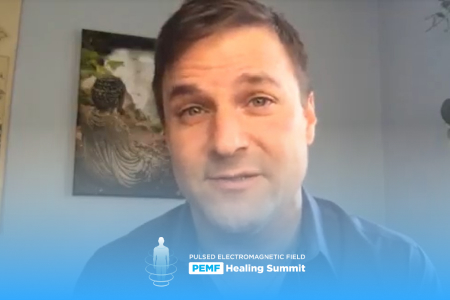Join the discussion below
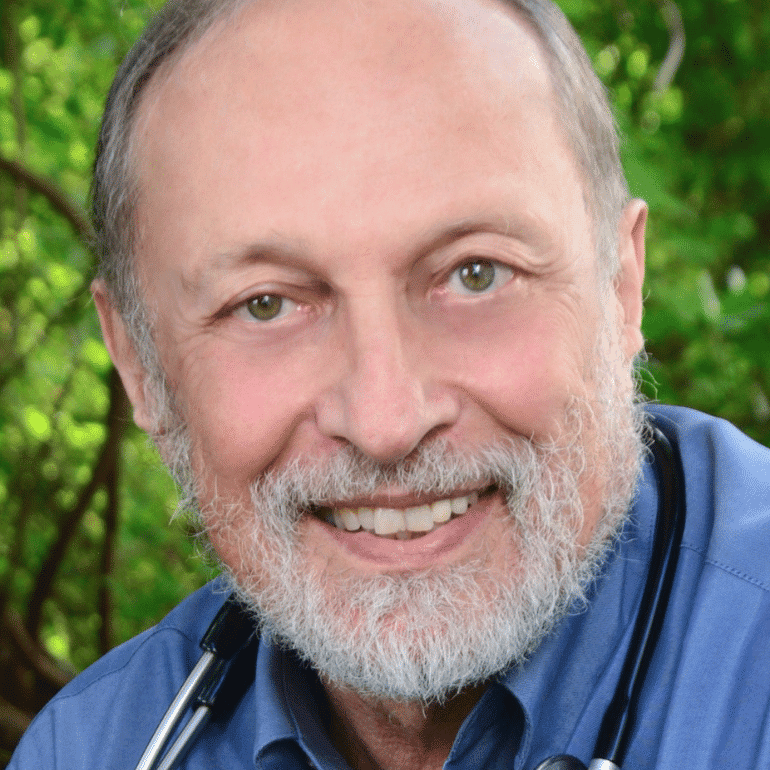
William Pawluk, MD, MSc, author of “Supercharge Your Health with PEMF therapy”, was recently a holistic doctor near Baltimore, MD. Previous academic positions at Johns Hopkins and University of Maryland. Training: acupuncture, homeopathy, hypnosis, energy medicine, nutrition and bodywork. Considered the foremost authority on the practical use of Pulsed Electromagnetic... Read More
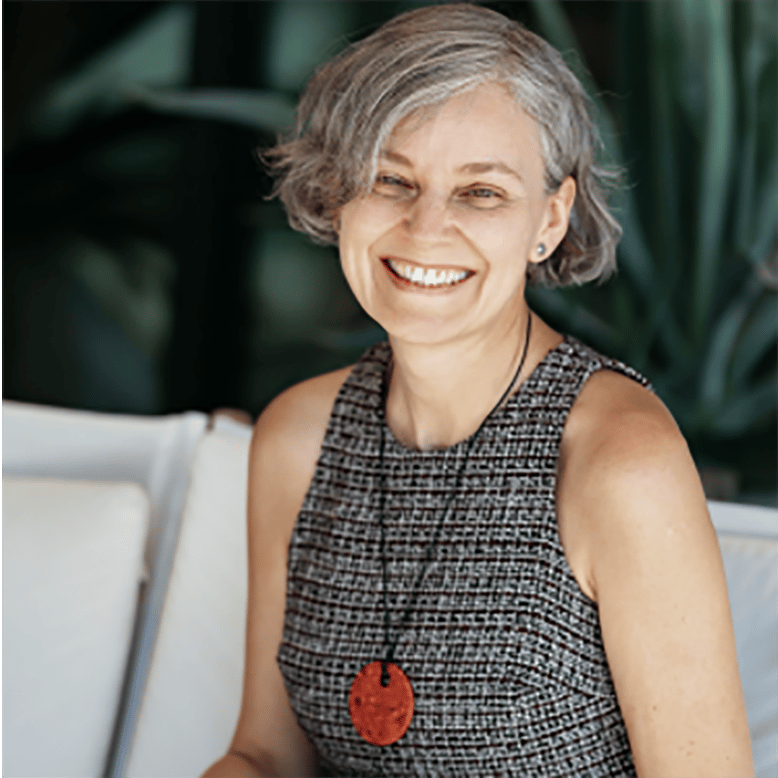
Kasia Kines, DCN, MS, MA, CN, CSN
Dr. Kasia Kines is a CEO and Founder of Global EBV Institute and Holistic Nutrition Naturally. She is an international leader in recovery therapy for Epstein-Barr Virus infections and the Amazon best-selling author of The Epstein-Barr Virus Solution. She is a Doctor of Clinical Nutrition, a Board-Certified Nutrition Specialist, and... Read More
- Dr. Kines did her PhD work on Epstein-Barr virus (EBV) and nutrition. She works extensively with people suffering from EBV. EBV causes a whole range of problems within the body, most commonly chronic fatigue and fibromyalgia. It is often associated with other viruses. The discussion included how to make the diagnosis, and how to properly test and evaluate for the presence of EBV. Treatment for EBV is holistic and includes mind-body work, supplements and, in some more severe cases, medications.
William Pawluk, M.D., MSc
So, welcome today to another special episode of the “PEMF Healing Summit.” And I have a dear old friend who’s with us today. And when I knew her, she did something very different and then she moved on and became an expert. An expert in EBV. And so, without me saying much about her, then let me ask Kasia, Dr. Kasia Kines. I call her Kasha. How do you wanna say it, Kasia or Kasia?
Kasia Kines, DCN, MS, MA, CN, CSN
Kasia, it’s always Kasia.
William Pawluk, M.D., MSc
Kasia is the Polish way to say it.
Kasia Kines, DCN, MS, MA, CN, CSN
That’s right.
William Pawluk, M.D., MSc
All right, so Kasia, please tell us about yourself.
Kasia Kines, DCN, MS, MA, CN, CSN
So, it’s so good to see you, Dr. Pawluk. So, we worked kind of together years ago, right? Years ago, many years ago. My name is Kasia Kines. I’m a doctor of clinical nutrition, and I am told I’m a global expert on Epstein-Barr virus. There’s not enough of us knowing that, that’s for sure. So, we have created amazing resources for people. So, we have kind of a herb website with resources, all evidence based for people online. We have consumer programs kind of a… Really, I work really close with each student. We have practitioner trainings, we have practitioner mentorship programs. I have the book and we keep going. We have to work, I haven’t finished yet. So, we… Our goal is… I’m a CEO of EBV is the educational Institute and Global EBV Institute. So, we hope to reach the first million people with a message of hope. And then, we’re gonna go from there.
William Pawluk, M.D., MSc
I know you’re being very modest. So Dr. Kines, when I knew her was not a doctor. She was a nutritionist and she was a superb nutritionist. I worked with her extensively as a nutritionist. I always like to refer people to her.
Kasia Kines, DCN, MS, MA, CN, CSN
That means a lot to me.
William Pawluk, M.D., MSc
But as she needed. She went on, she left the nest and went somewhere else and got her PhD. Tell us about your PhD.
Kasia Kines, DCN, MS, MA, CN, CSN
I was looking for clinical functional nutritional PhD for many years but couldn’t find anything that was worthwhile. And then, Dr. Liz Lipski, literally manifested a program like that herself. And she’s a friend of mine and a mentor. And so, she was in Maryland for a while. She connected with Maryland University of Integrative Health. They made it happen. She invited me to the forming committee I think it was and I just had to jump in, in the first cohort. So, could not wait. So, that’s what we did. I just jumped in and that forced me to really focused on EBV, writing the book during the due research ’cause otherwise, when you’re in clinic, you never have time. You just, you are in the trenches doing the work with patients but you don’t have the capacity to sat, sit down and write and create protocols in a book.
William Pawluk, M.D., MSc
Well, but for your PhD program, you have to become an expert in EBV. And I don’t think that you were necessarily an expert in EBV before you started your PhD, right? So, what did you learn?
Kasia Kines, DCN, MS, MA, CN, CSN
Of course.
William Pawluk, M.D., MSc
What did your PhD teach you about EBV that you didn’t know before?
Kasia Kines, DCN, MS, MA, CN, CSN
I actually was. The PhD, there was only one module on VIR virology, specifically with Dr. Vasquez. And that spark my interest because… So that actually helped because that is how I was able to start creating more protocols, but it was only like… It was only a little glimpse of it. He wasn’t even focused on EBV. It wasn’t enough. So basically, I was already working in the trenches with EBV and trying to figure it out and getting better and better and the doctoral program forced me to write. I needed to find the final project dissertation, so to speak. So, that’s where I had assigned time to write, to go through medical literature, systematize it. And so, that’s the way the program helped me. And so, once I had the 75 pages of documentation. Everybody, including my husband and Liz Lipski was telling me, where are you gonna write the book? And I said, what book? So, this is 590 pages.
William Pawluk, M.D., MSc
So, let us see your cover. Show your cover. So, it’s called The Epstein‑Barr Virus Solution.
Kasia Kines, DCN, MS, MA, CN, CSN
Solution, yeah, so people change their lives with that book alone. So it’s wonderful because doctors are recommending it to patients. Patients are buying it for their doctors. So, it’s just wonderful. It’s just starting to… Has been doing its job. And so, after this book, I started to create program online to leverage and to have access to people live because, book is limited and supplemental protocols in the book. That was the scariest thing ’cause I always worry that people will misinterpret, overdo, overdose and hurt themselves. So, but that why I have an entire chapter on protocols as well in the book.
William Pawluk, M.D., MSc
Well, let’s clarify something, ’cause a lot of people surprisingly know EBV and they don’t necessarily even know what it means.
Kasia Kines, DCN, MS, MA, CN, CSN
That’s right.
William Pawluk, M.D., MSc
Right?
Kasia Kines, DCN, MS, MA, CN, CSN
Epstein-Barr virus. it’s a Epstein-Barr virus.
William Pawluk, M.D., MSc
Epstein-Barr virus.
Kasia Kines, DCN, MS, MA, CN, CSN
Yeah, I think people know more about it now because of COVID. Because what happened with COVID, even Wuhan University started to do studies on COVID patients and then testing them for like several virus because it’s one of those big viruses that lacks to thrive when there’s coinfections. And is this is why, for example, I tested myself last fall when I started to notice that I probably was reactivating my own EBV because of my repeated mold exposure, which is common in our community. And so, with COVID it came to light. We have a big study, recent study on long haulers. And one study showed 73% of the group of long haulers actually had reactivated and they tested properly reactivated EBV. So, EBV is coming in the news right now. It’s interesting because there’s also a scary study, a big study on MS and EBV. So people literally come to me, they are scared that they’re gonna get MS if they have EBV. Well, we’ve had studies MS. They’re in my book. It’s not something new, but I think… I don’t know why they’re targeting this, they’re scaring people. And then, Moderna is coming up with a pilot study on vaccination for EBV at the same time. So, there is this climate of like, let’s scare the people. Let’s get them to, plug into one way of looking at the solutions.
William Pawluk, M.D., MSc
Well, but let’s back up even more. Okay, EBV has been around for forever.
Kasia Kines, DCN, MS, MA, CN, CSN
Millions of years.
William Pawluk, M.D., MSc
Yes, forever, right?
Kasia Kines, DCN, MS, MA, CN, CSN
A couple of years.
William Pawluk, M.D., MSc
So, it’s not new.
Kasia Kines, DCN, MS, MA, CN, CSN
No.
William Pawluk, M.D., MSc
And we used to call it mono.
Kasia Kines, DCN, MS, MA, CN, CSN
Right, we still do.
William Pawluk, M.D., MSc
Right? And so the people, kids get mono, so we say it’s mono, but so people know it as mono. They don’t know it as EBV. So if you had mono, that basically you have EBV.
Kasia Kines, DCN, MS, MA, CN, CSN
Right.
William Pawluk, M.D., MSc
Right, and you have it for life.
Kasia Kines, DCN, MS, MA, CN, CSN
Yeah, most of us are born with the virus. It’s a 90, 95% of global population has the virus. And that’s the common knowledge in medical literature and that’s probably why the researchers have been working on global vaccination forever. But it’s an opportunist. So you can have the virus, like I never tested until last fall. And ’cause, and I had antibodies. We do, we carry them but it doesn’t mean much if you functional. It’s only when you have opportunistic environments changes in your terrain, infections, stress, poor diet. There’s specific things that can trigger it, yes. So then…
William Pawluk, M.D., MSc
So, let’s go into that. So, this is a virus that’s ubiquitous.
Kasia Kines, DCN, MS, MA, CN, CSN
Right.
William Pawluk, M.D., MSc
Right, as you say, we’re born with it or it’s called kiss, the kissing disease, right?
Kasia Kines, DCN, MS, MA, CN, CSN
Kissing disease, yes.
William Pawluk, M.D., MSc
Right, adolescents get it, college kids get it, high school kids get it.
Kasia Kines, DCN, MS, MA, CN, CSN
Yeah.
William Pawluk, M.D., MSc
And so, that’s how we know it as mono. But as you said, “Most of us are exposed to it all the time.” One of the problems that doctors have and I found this myself and I started digging into it. There’s very little literature on EBV other than acute EBV-
Kasia Kines, DCN, MS, MA, CN, CSN
Not sure.
William Pawluk, M.D., MSc
And most of the medical community ignores it.
Kasia Kines, DCN, MS, MA, CN, CSN
Yeah, so it’s actually not true that there’s no literature and that’s why I had to write the book. So one third of my book is literature. That’s what I pulled. And I have to tell you, I had to stop looking to finish the book because if I looked at another condition, and I went to PubMed, I saw relationships. Today another condition, very unlikely, more relationships. At some point I stopped doing research and publish the book because the literature is there. It’s just that, like somebody has to sit down, plow through it, systematize it and put in a package and make sense of it. So, I think the problem with medical community is there’s no time to study this. And there is an old way of looking at it. And the old way of looking at it, you have mono, you done. Number one, you can’t have mono again and number two, any medical conditions after the mono are not related to that mono. Like mono is perceived as an end result and that’s it. But that’s not true because if you look at literature, you have chronic mononucleosis syndrome. And if you look at the symptoms of it, you can almost match it with chronic fatigue syndrome. And like you mentioned, you have a condition as a kid. One of my patients had a juvenile idiopathic arthritis as a kid. And she missed half a year of school. That’s traumatizing. She was very severely impacted physically by it. Over medicated, misdiagnosed. And then, she went to college, had depression and had mono. ‘Cause then like you said, “They anticipate that this is what it is.” But then by the late forties and I had known her before, but by late forties, she was almost suicidal. She was heavily depressed. She had all kinds of problems.
And so, I asked her to immediately test for how Hashimoto’s and EBV. Both were on. So, it’s like over the progression of your lives. This little virus keeps popping up, demonstrating, showing different presentations, where it just keeps going deeper into different organ systems. Depending on how you live your life. And of course, in that case, typically of EBV, there was a tremendous amount of personal stress at work. Really severe stress at work. And that is like chemical avalanche that will feed the virus. So, this is kind of how it goes. So, people don’t realize that there’s so many connections. So one of the things I used to tell my new patients is read the book and next time we talk, we talk about your life through the eyes of the virus. And inevitably its like, oh my gosh, all these events that were unrelated in my medical history and my hiccups and here and there, mystery conditions. Nice, I can track them. This is another layer of this virus. And that… So, in medical literature, researchers say, “If you have idiopathic condition “that doesn’t review chronic idiopathic condition, “that doesn’t respond.” You don’t know where it’s coming from. You need to test for chronic activated EBV. There’s research that say, “If you have a patient with chronic illness “and you’re doing the typical protocol, “and it’s not budging.” Again, that suggest you need test for chronic EBV, chronic activated or active EBV. So, there is research and those big mysteric conditions, which you and I in our clinical practice, work with, right? This is when I realized that some of the cases that I couldn’t help. They were, just glaring in my face, cases of chronic EBV with complications.
William Pawluk, M.D., MSc
So, we know ’cause it’s extraordinary common. Where does it like to settle in the body?
Kasia Kines, DCN, MS, MA, CN, CSN
Yeah, so it’s interesting and I don’t know why. So let’s say, enlarge spleen is typical of young boys. Hashimoto’s is common of middle-aged women. It’s not always like that but autoimmune hepatitis, the liver could be younger, could be long older. A few people will have encephalitis. Some people will have the virus in their inner ear nerve. Sometimes they go, almost deaf. It can get into the eye and almost cause blindness. I mean, I see all kinds of rare presentation, some cancers. So, it depends what kind of cancer tumors. It could be…
William Pawluk, M.D., MSc
What’s the most common cancer with EBV?
Kasia Kines, DCN, MS, MA, CN, CSN
What’s that?
William Pawluk, M.D., MSc
What’s the most common cancer from EBV?
Kasia Kines, DCN, MS, MA, CN, CSN
I think lymphomas. There’s 10 or 15% of stomach cancer, actually, interestingly. I mean, if you look at literature, 60% of EBV, whether it’s Crohn’s or ulcerative colitis are attributed to EBV as a causative factor. Not that you can turn it around because at certain point it’s delayed. There are so many autoimmune disorders that… There’s so many autoimmune disorders that are also connected to EBV, associated with it or even black and white are caused by EBV.
William Pawluk, M.D., MSc
So, you could even have MS.
Kasia Kines, DCN, MS, MA, CN, CSN
MS, so, there’s seven conditions that are directly caused by EBV according Dr. Harley study. And that’s from, I think three years ago. It’s a new study. MS, diabetes type one, idiopathic, juvenile rheumatoid arthritis. I’m gonna miss some. Celiac is the big one, and that is a new one. IBG, I mentioned. Did I miss more on. Oh, rheumatoid arthritis and Lupus.
William Pawluk, M.D., MSc
How about pancreatitis?
Kasia Kines, DCN, MS, MA, CN, CSN
I dunno, and you know, I haven’t looked at that PubMed, I should.
William Pawluk, M.D., MSc
Well, and the question is whether type one diabetes may be activated by EBV.
Kasia Kines, DCN, MS, MA, CN, CSN
Type one diabetes it’s the… Oh, type one. Didn’t I mention type one diabetes.
William Pawluk, M.D., MSc
No, not yet.
Kasia Kines, DCN, MS, MA, CN, CSN
I think it’s one of them. I’m pretty sure.
William Pawluk, M.D., MSc
I would take in rugby.
Kasia Kines, DCN, MS, MA, CN, CSN
Yes, type one diabetes. Yes, it is.
William Pawluk, M.D., MSc
Not type two, type one.
Kasia Kines, DCN, MS, MA, CN, CSN
Not type two, type one. Yes, exactly. That’s Dr. Harley. There was a specific protein from the virus that gets into the DNA in your cell that is coded for autoimmunity. If you have those genes, you can turn all those genes.
William Pawluk, M.D., MSc
All right, big question. Chronic Lyme disease versus EBV.
Kasia Kines, DCN, MS, MA, CN, CSN
Don’t know the answer. I have anecdotal stories and I found a study. I haven’t looked studies recently, but when I looked, I found one study saying, “That EBV can be misdiagnosed, “Lymes and one study” that saying that, “Lyme disease can be misdiagnosed EBV, “depending when you look.” I have anecdotal studies when people would try the long-term antibiotic therapy for their Lymes and they would deteriorate ’cause that’s really scary. But then, they would leave that path and go into a very different protocol that is much closer to antiviral particles. ‘Cause I talked to people and that was their recovery. That was the turnaround. So, I purposely don’t work with Lyme. If people have Lymes, that’s like, that’s. You have to do something on your own. I just don’t want to mix the two. So I don’t know.
William Pawluk, M.D., MSc
Well, here’s a challenge that I have. I think that because Lyme, because EBV is ubiquitous. If you have EBV in your system. Let’s talk, what you’re talking in a second about reactivation. But if you have EBV in your system already.
Kasia Kines, DCN, MS, MA, CN, CSN
Yeah.
William Pawluk, M.D., MSc
And then, you get Lyme disease. You get the actual acute infection from Lyme. You have the bull’s-eye rash. Then the infection from the Lyme, causes all kinds of habit with the immune system, right? And then what… Acute Lyme becomes chronic Lyme. And this is where I’ve seen people have antibiotics for months and months, IV antibiotics for months and months and months. No benefit.
Kasia Kines, DCN, MS, MA, CN, CSN
Correct.
William Pawluk, M.D., MSc
Right, because they’re dealing with the wrong organism. They’re dealing with the wrong illness. And EBV is very common. That’s what coronavirus is-
Kasia Kines, DCN, MS, MA, CN, CSN
Yeah, EBV…
William Pawluk, M.D., MSc
As well.
Kasia Kines, DCN, MS, MA, CN, CSN
Yeah, so, EBV tops into a couple of levels of a person. The physical level, also the emotional level. So, when people are terrified of Lymes. They have this level of anxiety. And so, that’s a perfect storm for EBV also to reactivate. When we stressed out, we don’t eat very well. And we have very, very clear studies if your nutritional status drops, your virus becomes more valorant. Junk food also means NF-kappaB, and then, NF-kappaB is one of those proteins that the virus likes to use to replicate. So, we have direct studies like showing this. So, it’s like mapping out where the person whose chronic illness is emotionally, physically in their kitchen, sleep pattern. All this can affect .
William Pawluk, M.D., MSc
Are their immune functional?
Kasia Kines, DCN, MS, MA, CN, CSN
Yes, whether, yeah, whether the virus can turn on or not. To that, like I said, I had never tested my virus ’cause I didn’t need to, until I had to move again and again and again, within short periods of times from one house to another because of mold. And then, I started to see some of the symptoms that were pretty indicative of EBV and certainly I had a little bit of it reactivated. It’s such an opportunist. So any infection that you have, if it’s a pretty severe that can… That’s in literature too. It’s called transactivation between species. If you have… I had bad strep infection or H. pylori is common. A common coinfection with EBV. You can reactivate EBV and another way around, if you have reactivation of EBV. You can reactivate other pathogens that you may have there.
William Pawluk, M.D., MSc
Do you have a typology of the progression of EBV? Can you talk about the progression of EBV.
Kasia Kines, DCN, MS, MA, CN, CSN
There’s some hypotheses, there’s one on autoimmunity and how EBV is involved in and I have it in the book. I say, that I’ve seen all kinds of patterns in, and it’s mostly women. But I’ve seen all kinds of patterns. It really depends on life, on stress management or what happens in people’s lives. And really, I think on the weakest link, because there’s some people believe that organs are according to your age. If you’re younger, it’s maybe spleen and maybe then liver and then eventually thyroid. If it’s true, I’m not sure. I haven’t seen studies. But then again, I’ve stopped doing studies after the book. There maybe some new ones. Good question.
William Pawluk, M.D., MSc
Okay, so, let’s say that you get the acute infection somewhere along the way or you inherited it. You were born with it, right? You end up in life with antibodies already.
Kasia Kines, DCN, MS, MA, CN, CSN
In birth, yeah. You can through birth.
William Pawluk, M.D., MSc
So that, at some point you got antibodies. Somehow you got antibodies.
Kasia Kines, DCN, MS, MA, CN, CSN
Yeah.
William Pawluk, M.D., MSc
Now, what happens?
Kasia Kines, DCN, MS, MA, CN, CSN
Nothing has to happen.
William Pawluk, M.D., MSc
But you have virus. Your virus .
Kasia Kines, DCN, MS, MA, CN, CSN
Now we have millions of them. I think somebody said, trillions.
William Pawluk, M.D., MSc
That is horror articles.
Kasia Kines, DCN, MS, MA, CN, CSN
Somebody.
William Pawluk, M.D., MSc
Now, do you need the whole virus or can you have components of DNA?
Kasia Kines, DCN, MS, MA, CN, CSN
Components on DNA leaves the blood. So, the virus travels in the blood just for a short period of time during lysing. The goal of the virus is to leave the bloodstream and find a condyle to live in. Whether it’s thyroid-
William Pawluk, M.D., MSc
Haldol.
Kasia Kines, DCN, MS, MA, CN, CSN
Or spleen or liver. And so, looking for DNA is not that reliable.
William Pawluk, M.D., MSc
So I saw an article one time that’s, EBV hides out in the lymphocyte.
Kasia Kines, DCN, MS, MA, CN, CSN
Yes, yes, yes, and that’s why…
William Pawluk, M.D., MSc
Well, tell us stories about that.
Kasia Kines, DCN, MS, MA, CN, CSN
That’s why one of the major thing I teach people to do is move the lift because this is often. Tonsils, the mouth is the entry. So this is close to the brain, of course. You’ll have all this engagement. So for most people, this is painful and large. Sometimes you have tumor growth here that, it starts going. So, while you can’t exercise, when you have EBV, because that’s more oxidative stress and more EBV symptoms. We do rebounding. Very gentle to start moving the lymph on lymph drainage massage. In some cases, we have… In my program, we have instructions how to do lymphatic massage. We had a massage therapist retired who map it out for us. So, that’s very important. Lymphatic, yeah, absolutely. This is where you’re gonna have so much inflammation and stagnation, and that can really backfire.
William Pawluk, M.D., MSc
So, it doesn’t have to rely on lymphocytes side on the lymph nodes. The spleen of course, is a major reservoir. The liver is a major reservoir. The lymph nodes are a major reservoir, but it’s also lives on the lymphocyte. So, we’re talking about circulating lymphocytes that are chronically have EBV.
Kasia Kines, DCN, MS, MA, CN, CSN
Mostly, will be B-cells and T-cells.
William Pawluk, M.D., MSc
Okay, well, there you go, but that’s lymphocytes.
Kasia Kines, DCN, MS, MA, CN, CSN
Yeah, mostly, and interestingly in Japan, it seems like there’s more T-cells and in… Here it’s small B-cells typically. But yeah, it’s like we have to live with it, although it likes to be latent. And so, I think the the more… What I see is the more antioxidants we have, the more we can turn them off. But the biggest issue for me is the environmental external issues, like the pollution in the foods but also just the environmental issues like dioxin in the air. There are things that directly reactivate the virus, right there and then. And actually mold is one of them.
William Pawluk, M.D., MSc
And mold is wild. How about…
Kasia Kines, DCN, MS, MA, CN, CSN
The mold is absolutely one of them. And Wi-Fi technology is one of them.
William Pawluk, M.D., MSc
How about, glyphosate?
Kasia Kines, DCN, MS, MA, CN, CSN
Glyphosate I don’t see the studies, but I would say not unlikely, but I know for sure if you have a combination of heavy metals, Wi-Fi technology, mold and dioxin. Let’s say, you have a wood burning stove or wood burning fire at home. That’s like a… That’s really a bad, bad combination. That’s why I reactivated in this house, a month after we moved in because of the residue of the mold that my body was dealing with, but also smart meter that the house came with. I’m still waiting for it to be removed. And, everything was piled up in one corner of the room and boom, I developed vertigo. I had never had vertigo in my life. So, I put myself on the protocol. 24 hours later, I was fine. Moved my desk. It was fine. So, you can… When you start to create that horological map in your brain of where the virus likes to fight you. What kind of circumstances you can expect to reactivate it. And if you know the protocols, if you know what to do, you can turn off within 24, 48 hours. That’s my biggest goal for my community. Let’s go through the whole education first, all the tools, and then typical factors that reactivated. So you can expect, and people do what I do. You can feel it coming back. You already know what your symptoms are. Typically, you feel it coming back, you can zap it. So it’s not invincible. It’s kind of predictable and we have medical research. I’m gonna quote, “it’s treatable, reversible “and sometimes even rapidly.”
William Pawluk, M.D., MSc
Let’s hold that thought and we’re gonna cycle back to it ’cause the rest of the discussion, I think, needs to be on treatment. But before we get to treatment, how do we know we have it? How do we test for it?
Kasia Kines, DCN, MS, MA, CN, CSN
Yeah you need four antibodies, typically. And you don’t want to skip any, so you have a context. You want all four and then you need patients context, like .
William Pawluk, M.D., MSc
Which four?
Kasia Kines, DCN, MS, MA, CN, CSN
VCA IgG, VCA IgM, EBNA IgG and EA IgG.
William Pawluk, M.D., MSc
Say the last one, again.
Kasia Kines, DCN, MS, MA, CN, CSN
EA IgG.
William Pawluk, M.D., MSc
Okay, EA, early antigen. So what are the… What’s the relevance of the four.
Kasia Kines, DCN, MS, MA, CN, CSN
The VCA IgM. We don’t see it turn on with reinfections. We typically see it and act like fuel cut literature and also what I see. It’s more of the first time activation.
William Pawluk, M.D., MSc
Which is typical for IgM.
Kasia Kines, DCN, MS, MA, CN, CSN
Which is typical for IgM. It can, I’ve had a handful of cases where constantly shows up. Anytime they do the testing. And there’s some literature saying that, “It is molecular mimicry or coinfections, “something else going on.” But typically, it’s expected it to be normal in the chronic EBV. Typically, when people have first mono. They probably will end up at the doctors and it’s pretty obvious. That is the first time on a mono. But the chronic one is FE, so…
William Pawluk, M.D., MSc
That’s probably the Monospot test, right? It’s IgM.
Kasia Kines, DCN, MS, MA, CN, CSN
I’m not that familiar with Monospot, actually. I just work with the antibodies.
William Pawluk, M.D., MSc
Okay, well, Monospot test is an antibody test but I think it’s basically, it’s a very quick swab.
Kasia Kines, DCN, MS, MA, CN, CSN
I see.
William Pawluk, M.D., MSc
And usually, it’s kids that come in with the obvious glandular manifestation-
Kasia Kines, DCN, MS, MA, CN, CSN
Glandular fever.
William Pawluk, M.D., MSc
And you do the Monospot rather than doing blood testing. You do Monospot and you can diagnose it right there. So, I’m presuming that that’s gonna be IgM.
Kasia Kines, DCN, MS, MA, CN, CSN
I don’t know. That’s a good question. You see, I don’t know everything.
William Pawluk, M.D., MSc
That’s okay, rather either do I. That’s why I asked that question. All right, so, now you have IgM, you have go ahead with the other ones.
Kasia Kines, DCN, MS, MA, CN, CSN
So then you have the two big ones, VCA IgG and EA and EBNA IgG. These are the ones that you have for lives. And so, they will be elevated if you’ve had exposure. But if you have triple digit, that’s the problem. If you have more than, 600 or more than 700 round.
William Pawluk, M.D., MSc
From left to right .
Kasia Kines, DCN, MS, MA, CN, CSN
That’s typically a problem ’cause that can be 2000, you know, you don’t know. And so, then you look. Okay, is this person healthy and living their lives? So, typically with those numbers. They’re not doing well. So, these tend to fluctuate a little bit up and down with reactivations. And so, but if you are improving, so they will drop and drop and drop, but it will never go to zero. You always have some of them. And then the fourth one, and this is a tragedy because there are panels that doctors use that only do three and I missed this one. And sometimes patients, they’re educated. They requested, and even if they requested, sometimes they miss it. So, that’s a tragedy of… Without this, you really don’t know what you’re looking at. So, early antigen is the one that shows current reactivation. It doesn’t have to be very high to be positive. And you have a window of two, three weeks to capture it. So, when your cells lyse, you don’t want to wait. So let’s say, ’cause it comes up and down. So let’s say, I had a student once who told me I have a classic chronic VVA, but her early antigen was negative. So, what do I do with this? So I said, well, when did she test in January? So I asked, when was the worst time when she felt like, she was hit by a truck? Like when was Thanksgiving? I was like, wow, good luck to you. So, if you really the sickest, that’s where your immune is hardest but that’s where you wanna test to see the early antigen is there. And then, with the antibodies, there’s some irregularities, like, a percentage, 10, 15%. Do not manufacture one of these antibodies.
And sometimes people have to zero. There’s like clean, cleans like… There’s only one lab that I’m aware of that test. Let’s see which one is it. EBNA IgM. And so, with that person, I tested that lab. So, I had the fifth antibody and that was the only one that was elevated. So we would’ve missed it. But if I would say, if you do the four, oh, the panel and it’s all completely clean, then I would test total immunoglobulin inside IgD, IgM, IgA. And then, recalculate with a calculator. Okay, this is the ranch and this is so long. What would it be if she was making that one? So, that’s kind of the story. But I would say, you never like, you’re the doctor. You know what to say. You don’t treat the lab, you treat the patients. So, there’s always that context. And the context is like, I think my book helps people because they see the context of where and how this virus can manifest and their stories of patients. And so, that becomes . So they can make connections about their life stories and the journey where that virus was actually already impacting their health. And it’s pretty empowering, because these are the people. Like you remember that are so anxious about their health because they’ve been through the ringer. They have millions of diagnosis. They’re afraid of another autoimmune condition, like stacking up. And so there… If there’s even EBV on the horizon, then they’re scared of cancer.
William Pawluk, M.D., MSc
Right.
Kasia Kines, DCN, MS, MA, CN, CSN
So, it’s really important to see the context of the story and give people help saying, it’s just a virus. It can turn on, but is predictable. We can turn it off. The stool, it’s not true that you can get rid of it. It’s not true that you can live like that. None of that is true. It’s possible to turn it around. That’s the best part of it.
William Pawluk, M.D., MSc
Now, I routinely recommend immunoglobulin testing. If you have somebody with chronic conditions, chronic fatigue, especially, but just any just general chronic conditions. You have to always think that there’s a problem with this immune system. And so, in addition to building the EBV antibody levels. I will do other viruses too, right? Because, ’cause they can be their HHV-6, CMV are very common co-writers, right? With EBV.
Kasia Kines, DCN, MS, MA, CN, CSN
Sure.
William Pawluk, M.D., MSc
So, if you do a full panel, you really should do a full immunoglobulin panel as well. Because if you have low IgM levels or low IgG levels, even though you’re positive with IgG, for EBNA or and VCA. You could still have low general levels. Which means that you’re basically in some ways, a sitting duck as well.
Kasia Kines, DCN, MS, MA, CN, CSN
Right, that’s true.
William Pawluk, M.D., MSc
So, let’s talk about, you said you can kill the virus? What are the conventional medical therapies for?
Kasia Kines, DCN, MS, MA, CN, CSN
We can turn it off. I don’t really kill it. And I don’t like this vocabulary ’cause killing causes so much toxic debris. Like a Monolaurin lower siding. That kills the envelope. And that is a problem because it creates a havoc on the compromised already body.
William Pawluk, M.D., MSc
Okay, repeat that lower siding and Monolaurin.
Kasia Kines, DCN, MS, MA, CN, CSN
Yeah, we don’t use it in the protocol. I only resort to it if we have coinfections like overgrowth chronic overgrowth of Candida or H. pylori because they deliver. So, if that’s worth it but we have to be careful for the… I have it all explained in the book because a lot of people don’t tolerate it. You have to be very careful with dosing. It can tip you over and create a havoc ’cause of die off and it’s dangerous for a person who is so sick.
William Pawluk, M.D., MSc
What about the standard medical therapies?
Kasia Kines, DCN, MS, MA, CN, CSN
Well, medical literature says, “low efficacy.” The doctors that I trained, I asked them, don’t work. And then the community of people are coming to me, didn’t get better on it. So kind consistent, 95%, I would say there’s 5% that can swear by it, but that’s not good enough.
William Pawluk, M.D., MSc
But why? Why don’t they work?
Kasia Kines, DCN, MS, MA, CN, CSN
I think, if have a one target, one persuades in one month pathway in which pharmaceutical targets a virus. It’s not enough. I think the value in the protocol advised is we hit the virus in different ways with different nutrients. And at the same time with multitask, with those nutrients. There are high antioxidants. So the virus hates. They’re highly anti-EBV antiviral and they are nutrients. So they actually start boosting your immune cells.
William Pawluk, M.D., MSc
Immune.
Kasia Kines, DCN, MS, MA, CN, CSN
Even immune cells also need basic nutrients. And there are certain things that the virus targets. Targets mitochondria. You need maybe more magnesium. But when you target it this way and look at the environmental input. You don’t inhale, fireworks. You don’t inhale the fire burning forest. When you start orienting yourself and you have the right tools. It’s very different from one medication. It just can’t do it. Just not possible for one medication to do that when the virus is so insidious.
William Pawluk, M.D., MSc
Well, in fact, actually that’s an important point because what we see with H Hep C and what we see with HIV is that we have cocktails of antivirals and those antivirals are virus recital. What’s the most common antiviral we use for EBV?
Kasia Kines, DCN, MS, MA, CN, CSN
Non-medication, you mean?
William Pawluk, M.D., MSc
The medication.
Kasia Kines, DCN, MS, MA, CN, CSN
You asking me?
William Pawluk, M.D., MSc
Yeah.
Kasia Kines, DCN, MS, MA, CN, CSN
Medications are not my forte.
William Pawluk, M.D., MSc
Okay, but the most common medication, the same one that we use for shingles. It’s not virus recital. It’s virus static. Just like we have virus recital or virus recital, bacteria recital antibiotics for bacteria. We have bacteriostatic antibiotics for bacteria.
Kasia Kines, DCN, MS, MA, CN, CSN
Oh, that’s interesting.
William Pawluk, M.D., MSc
So, all the bactostatics do is they stop the progression of the growth of the bacteria. They don’t kill the bacteria. They stop it from multiplying, right? And we do the same thing with the shingles virus.
Kasia Kines, DCN, MS, MA, CN, CSN
The shingles, yeah.
William Pawluk, M.D., MSc
Ribavirin, so, what happens then is that we don’t have virus silos. We’re not killing the virus. All we’re doing is suppressing the growth of it. So, you’re not going to be able to deal with, if you have an active escape of the virus and it’s growing rapidly. Then a virus silo, a common virus silo. Can potentially help someone. but it’s not going to do… It’s not gonna finish the job.
Kasia Kines, DCN, MS, MA, CN, CSN
Right, because they’re just gonna… Whatever you don’t kill. They’re just gonna travel into your cells and .
William Pawluk, M.D., MSc
And it can become even more chronic. that become buried even more.
Kasia Kines, DCN, MS, MA, CN, CSN
Right, buried into cells, yeah, yeah.
William Pawluk, M.D., MSc
So, talk more about your protocol. What’s your favorite protocol? What do you recommend as a baseline? I know it’s in your book, but let’s talk about it.
Kasia Kines, DCN, MS, MA, CN, CSN
So, if it’s just EBV, it’s pretty straightforward. If you add those components of your life plus the supplements, diet, sleep and stress and all that and environmental toxins. What is an issue is that it often comes in the bucket with the friends. So, there’s complications. And so, really in order to understand how much of what happens to the person that has chronic issues? How much of it is EBV? I created and in and preliminary protocol and we focus on that alone in the first three, four weeks. It’s heavy-duty, it’s aggressive, it’s seven supplements plus vitamin D. That goes without saying and we watch. Because it’s predictable, it’s evidence based, it works, it’s pretty aggressive. So, you start seeing some things starting to shift and the needles starts to move. So people are more stable, less brain fog, less fatigue, start thinking properly. Sometimes people ask, is there placebo effect? ‘Cause I can’t be feeling so much better, so fast. So ,it’s like expected that this will deliver. And if it doesn’t like, if you are on it for two, three months and you only like 50% better, 40% better then we look deeper. Like we look, okay. Where is that mold or where is, what else is going on? Yeah, so we have these layers. That’s how I design the program. So we just, we can learn once about your life and your body.
So the initial protocol, we call it, the EBV Jumpstart Bundle. You have aggressive doses of NAC, selenium, lysine. You have some zinc vitamin E, vitamin E, vitamin C. And the only herbal botanical that I use at that point is Licorice. If people can handle it. And so, but we have aggressive doses, like selenium, we drive it up to 800 micrograms depending. And NAC is safe, medically safe, up to 4,500. We don’t go quite as high, but I wanna push it. And so, people with chronic disease sometimes have multiple sensitivities to any supplements. And sometimes it takes them a while to take one, two cups or three cups to build it up to the highest that they can tolerate. And so, we stack it up. Once you have that, and then you run it for three weeks, then that’s you start seeing things happen. And then, we built up a fuller protocol and we add the diet, we add all kinds of components, and then… So, that’s pretty straightforward and really it’s just evidence based. And then, I kept tweaking it in my practice and saw a consistent. Consistent progress and recovery. So, it’s a robust process because you want to look at environmental toxins. You want to look at the air quality or water quality, EMF. You have to learn these things. I mean, it’s such an opportunist.
William Pawluk, M.D., MSc
Do you have these other factors after you start your initial protocol, or do you try to do as much as you can at the beginning?
Kasia Kines, DCN, MS, MA, CN, CSN
I do it a little EMF challenge. I have like a bullet of 10 things to turn down the volume on Wi-Fi. That is simple for people just to… It’s like, where do you start? We have such unhealthy lifestyle, where do you start? But the people that at least come to me, they just tried everything. Like, not for the lack of trying. So, they’re really motivated and they do the work. And when they do the work, they can really create a life. And then, I support them with spiritual growth and more tapping into the joy, moving them towards a life that is meaningful, is powerful service to this planet. So people are really fulfilled. It’s not just about getting healthy physically. That’s not what I do, like that’s type of surface part. But the secret is really to move people to the spiritual empowerment and finding the dreams and following them and being a service.
William Pawluk, M.D., MSc
Kasia Kines, DCN, MS, MA, CN, CSN
Yeah.
William Pawluk, M.D., MSc
So, what’s your thinking about PEMFs? Since this is a PEMF Summit.
Kasia Kines, DCN, MS, MA, CN, CSN
Yeah, I don’t know much about it. I don’t use it, I don’t think I’ve used it. Some of my students will experiment with different therapies like that and ask me questions. I think it has so many opportunities. I just haven’t had the tools. So, I haven’t physically tried them. I used to see your machine. You had some tools in the clinic, remember.
William Pawluk, M.D., MSc
Right.
Kasia Kines, DCN, MS, MA, CN, CSN
Way back then. But I never used it on me, so-
William Pawluk, M.D., MSc
So let’s just put it into context. We don’t know whether PEMFs will kill the virus or not. And PEMFs are basically supportive to the whole body in general.
Kasia Kines, DCN, MS, MA, CN, CSN
Right.
William Pawluk, M.D., MSc
Right, so they… But one of the most important things that PEMFs do in conjunction with whatever else you’re doing is if you can make. And the same thing applies to Wi-Fi. You can’t necessarily get rid of all this stuff. But what you do is you make the body healthier and the body becomes more resist.
Kasia Kines, DCN, MS, MA, CN, CSN
Yeah.
William Pawluk, M.D., MSc
So if you can increase ATP in the cells. If you decrease inflammation in the body in general, right? Then the opportunists don’t have , a garden to grow in.
Kasia Kines, DCN, MS, MA, CN, CSN
It’s a terrain, yes. So, it’s a little bit like vibrational frequency.
William Pawluk, M.D., MSc
Not necessarily, so, what happens there are, you can configure PEMFs that way. But most of my perspective has, is based on the fact that what you try to do is to increase the energy in the cell. If you increase the energy in the cell, the cell has more vitality. If the cell has more vitality, it’s more resistant.
Kasia Kines, DCN, MS, MA, CN, CSN
Yeah.
William Pawluk, M.D., MSc
So, not only is it more resistant, but also becomes more repair regenerative.
Kasia Kines, DCN, MS, MA, CN, CSN
So that would definitely work for somebody with chronic EBV, definitely.
William Pawluk, M.D., MSc
I would think so. With not only with chronic EBV, but basically almost any chronic illness.
Kasia Kines, DCN, MS, MA, CN, CSN
Chronic illness, yes.
William Pawluk, M.D., MSc
And EBV being the biggest opportunist. So, anybody doing a lot of EBV work. And I would say that probably in your population, if they’ve tried what you do and they’re still struggling and they’re still relapsing or going back and forth and back and forth. Then they probably need to add something in the background that basically supports the whole body.
Kasia Kines, DCN, MS, MA, CN, CSN
Create a different baseline for the cells. Yeah, absolutely.
William Pawluk, M.D., MSc
And it helps the cells actually to absorb and use nutrients better.
Kasia Kines, DCN, MS, MA, CN, CSN
That’s perfect because that’s the answer right there for EBV.
William Pawluk, M.D., MSc
Right, it does some, so do so many things. And in my books, a supercharge of health with PEMF therapy. We talk about adding PEMF therapy to other protocols. PEMF don’t work entirely on their own. They need that nutritional support. They need all the other lifestyle factors that you need to be healthy.
Kasia Kines, DCN, MS, MA, CN, CSN
Yeah.
William Pawluk, M.D., MSc
But you can’t be pouring gasoline on the fire, as I say, and then do magnetic fuel therapy, hoping that it’s gonna put out the fire.
Kasia Kines, DCN, MS, MA, CN, CSN
Right, it’s in the context but it’s a beautiful agent. No, definitely, so I do need to read your book.
William Pawluk, M.D., MSc
I think you do. I will have to make sure that get it.
Kasia Kines, DCN, MS, MA, CN, CSN
I do have it and I will read it because it would be amazing for our community, definitely.
William Pawluk, M.D., MSc
I would like to hear some really good reports from your community and using it and you personally.
Kasia Kines, DCN, MS, MA, CN, CSN
You will, but they’re pretty, yeah, they’re pretty vocal. Yeah, I would like to test it too, absolutely.
William Pawluk, M.D., MSc
We’ll have to talk about it.
Kasia Kines, DCN, MS, MA, CN, CSN
So, we have to talk about it.
William Pawluk, M.D., MSc
I know you have to go, I know you have another appointment. Do you have any parting thoughts or comments or suggestions?
Kasia Kines, DCN, MS, MA, CN, CSN
A very ironic statement that I’ve heard before from our community is that in some cases, EBV is the biggest teacher. Because basically if you have balanced body, spirit body, physiologically, physically, mentally, emotionally. It’s very hard for that virus to do the damage to lies, to trickle into medical conditions. And so, in a way we have so much toxicity. We are so out of sync with our dreams, who we are, what we represent, the relationships we have, the jobs we have. 80% people in the states hate their jobs. That’s awful. We’re designed to do what we love, be in full integrity and be of service. So I mean, I think, and we have so much toxicity. So all these layers and EMF now, and mold now because of how we build the houses. So, where we are pretty insulted and I think when people tell me it was my biggest teacher. It’s a hard pill to swallow for somebody who has chronic review, right now because it’s so tragic, it’s disabling. But in a way, if you can get over it. It means that you take the journey of self love ultimately and there’s things that need to be changed because of our environment, because of our lifestyle that is not sustainable. So that would be my message. A message of hope and the fact that it’s… We get so many resources, you can start on the journey, you can get better and you have… Your resources are amazing as an adjunct because fantastic. Also self love, just self love. You pick it, you use it because you’re worth it. And then, just addressing what’s not synchronize with who you are in your life. Can you step in and show up for yourself and say, this is what I need to do. So-
William Pawluk, M.D., MSc
That’s another factor it’s like bad nutrition, so bad ideas, bad feelings, right? That’s .
Kasia Kines, DCN, MS, MA, CN, CSN
Physiology thoughts come from nutrients too. Way when we are stressed, we eat poorly. I mean, that’s just physiology. You have different chemicals, screaming sugar ant. Self medication.
William Pawluk, M.D., MSc
The quick fix, right?
Kasia Kines, DCN, MS, MA, CN, CSN
Yeah, yeah, that’s just. It’s a difficult time we live in, as a human species. It’s very demanding and we don’t have a tribe. We don’t have support. So, especially for women. So yeah, so, something is to give and I think the virus is a good indication that’s happening in somebody’s life.
William Pawluk, M.D., MSc
Well, that’s what we’re seeing through this summit. There are many ways that you can become activated. There are many ways by cancer, for example, or autoimmune diseases.
Kasia Kines, DCN, MS, MA, CN, CSN
Right.
William Pawluk, M.D., MSc
There are many ways of becoming activated. Once you become activated, then you have to step outside the conventional medical system because its job is very limited and you’re not gonna become self-actualized, you’re not gonna become sort of independent in your own ability to take care of yourself, relying on that system. Now, it has its place, of course, right?
Kasia Kines, DCN, MS, MA, CN, CSN
Yeah.
William Pawluk, M.D., MSc
Once you become activated with anything, including EBV, then you have to start on that journey.
Kasia Kines, DCN, MS, MA, CN, CSN
Yeah, it’s a journey definitely. Better get ready.
William Pawluk, M.D., MSc
Well, we’re getting ready and thanks to you we’re gonna be able to move down that road much better.
Kasia Kines, DCN, MS, MA, CN, CSN
Oh my gosh. Your work is amazing. I’m just honored to be here.
William Pawluk, M.D., MSc
Well, thank you for being here and I’m honored as well. It’s great to see you again clearly.
Kasia Kines, DCN, MS, MA, CN, CSN
It’s wonderful.
Downloads
